
The Oregon Lab Where Scientists Are Riding the Waves to a Brighter Future
At the O.H. Hinsdale Wave Research Lab in Corvallis, massive simulators allow researchers to test innovative ideas about sustainable energy, saving coastlines, and more.
On the far western edge of the Oregon State University campus, tucked between verdant farmlands and a sports field, an extraordinary facility is hosting experiments that could save humanity. It’s called the O.H. Hinsdale Wave Research Lab, and it’s one of the only places in the world where engineers can build a shoreline to order.
Housed inside two cavernous warehouses, the place echoes with the sound of breaking waves, and there is a slight tang of chlorine in the air. Bisecting the warehouse is a long, narrow trough of churning water, its cement walls studded with instrumentation and topped by a motorized catwalk that slides on tracks over the choppy swells. Called the Large Wave Flume, this unique scientific instrument is the largest of its kind in North America. It measures 12 feet wide by 342 feet long—about the length of a football field—and behaves like a perfect slice of shallow coastal ocean.
On one end of the flume, massive hydraulic pistons attached to a broad, flat paddle can generate waves up to five and a half feet tall every five seconds. On the other end, the bottom of the trough slopes up steeply to form a narrow concrete beach. Wave after perfect wave breaks across the rocky floor, foaming up and slurping back out just like they would on the nearby Oregon coast.
The facility is also home to an equally impressive directional wave basin, 87 feet wide and 160 feet long, nicknamed “the steel beach.” Its “shoreline” is tiled with reconfigurable metal plates, its tides generated by 29 separate hydraulic paddles. Sometimes the metal plates are replaced with models of coastal cities, complete with tiny houses and people, to be destroyed by miniature catastrophic floods. Occasionally, the steel beach is battered by artificial tsunamis so powerful that they shake the windows of offices on the other side of the building.
Anyone using the Wave Research Lab comes prepared with a wetsuit. Researchers often have to swim or kayak to access their experiments.
For 50 years, engineers and visionaries have been using the lab to learn about everything from the physics of fluid dynamics to what happens when a tsunami hits a bridge. It’s a place where entrepreneurs and scientists alike can book time on the equipment alongside machinists and undergraduates. But these days, many of the lab’s experiments are focused on one thing: how climate change is rapidly redrawing coastlines around the world, and what seaside communities can do to protect themselves.

Lab director Pedro Lomonaco leans against the damp wall of the large wave flume, his salt-and-pepper hair slightly tousled in the breeze whipped up by the waves. He’s studied coastal environments his entire career, running hydraulics engineering labs in Europe and Canada before landing at the Wave Research Laboratory here in Corvallis. But Lomonaco’s fascination with the interaction between water and land started much earlier. Growing up in Mexico, he always loved visiting the beach. “For a long time, I kept sand from every beach I visited in little film canisters,” he says. “But then that got to be too heavy to carry around.”
Lomonaco has the genial vibe of a surfer, but he describes the waves with an engineer’s precision, detailing how scientists measure each swell with an array of sensors.
As he speaks, I notice the flume waves are doing something odd. Their edges break bigger and earlier than their centers. At a facility devoted to creating perfect waves, it seems strangely imprecise. Lomonaco grins and points to a group of researchers gathered around a bank of computers about halfway down the flume from us. Their experimental prototype, part of a coastal protection project called Emerald Tutu, is dampening the waves, robbing them of some of their energy before they crash on the cement shore.
I’m not sure what I was expecting to see when I joined the team huddle, but it wasn’t a 5-foot-wide, lumpy brown blob floating in the water, encased in webbing and studded with Pink Panther floaties. Long plastic tentacles trail from its underside like vinyl seaweed. Using customized cameras and sound wave emitters embedded in the flume, they measure the water’s height and chaotic currents.
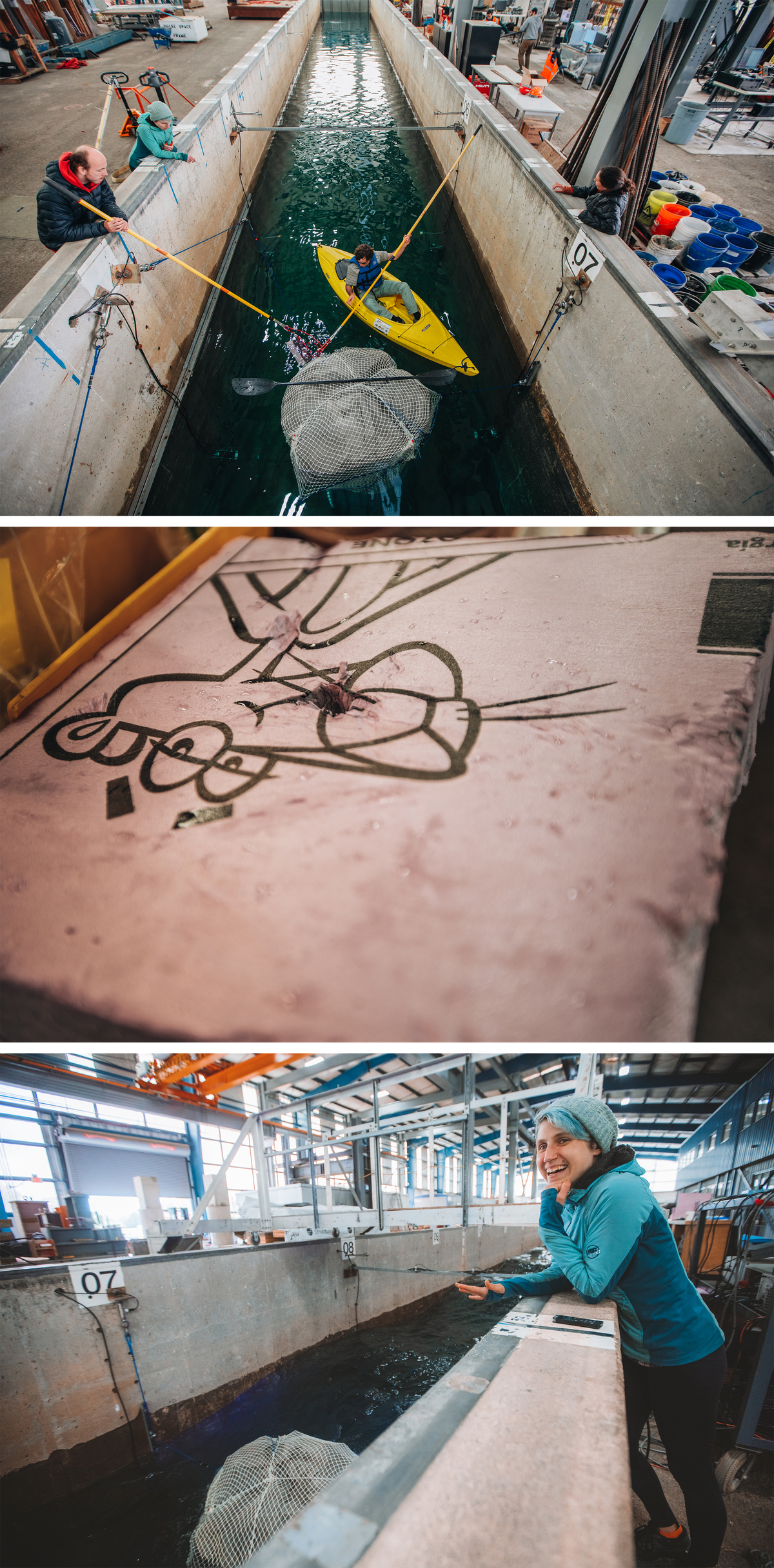
Lead investigator Julia Hopkins, a professor of civil and environmental engineering at Northeastern University, squints at data scrolling up the monitor as waves batter the prototype. A wisp of blue hair pokes out from under her hat as she confers with graduate student Tyler McCormack on how high the “chungus” was riding in the water.
Pen poised awkwardly over my reporter’s pad, I wonder if she’s kidding. “What does chungus mean?”
Without missing a beat, his attention divided between data tracking and his phone, McCormack reads aloud from Dictionary.com: “It’s ‘a slang term for anything that is adorably chunky’.”
At second glance, the chungus is kind of adorable, slopping around in the water like an aquatic beanbag chair. Just then, a splutter of sound comes from a rugged walkie talkie next to the computer. “Ready?” a voice asks.
“Ready,” McCormack replies. He waves up at lab researcher Rebekah Miller, standing in the window of an office above us. She pushes a button on her computer to initiate a new set of waves and, with a groan, the wave paddle begins to move and the water starts rippling once more.
As the agitated water surges into deeper troughs and higher swells, architect Gabriel Cira joins the rest of the team, beaming at the wet chonky boi floating below. He is, as Hopkins puts it, the “mastermind” behind Emerald Tutu.
Adjusting his sunglasses—“I can’t deal with fluorescent light,” he explains—Cira says that future versions of this chungus would be connected in a vast network, their plump bodies seeded with marsh grasses and seaweed. Eventually, they would form floating gardens surrounding coastal cities like fluffy green tutus, potentially saving them from disaster. Just as this single prototype had absorbed enough energy to change the behavior of waves in the flume, a network of them could dampen a real-world storm surge.
According to Cira, the Emerald Tutu networks would be indistinguishable from natural marshes filled in or otherwise eliminated in the 18th and 19th centuries along many of our coastlines. The plastic tentacles hanging off the chungus, for example, would simulate the plants that will eventually grow on them in the wild. “It becomes a dense, spongelike, floating environment,” Cira says. “Animals will love it as well.” A prototype chungus that the team placed in an East Boston harbor last year grew a dense green cap that became a home for crabs, birds, and worms.
“We don’t normally think of plants as infrastructure, but we should,” says Cira. He’s part of a new wave of architects and city planners who want to build soft “green infrastructure” instead of traditional concrete “gray infrastructure.” Federal funding should go to green infrastructure, he points out, because it will lead to better coastal protection and more jobs. “Green infrastructure requires monitoring, maintenance, and upkeep,” Cira says. “We think that local communities can be involved in that, financially, in a way that they aren’t with gray infrastructure.”

It’s not unusual to hear people at the Wave Research Lab talking directly about the social impact of their research—after all, this facility is explicitly designed to help engineers innovate better coastal infrastructure for cities and industry, at a time when climate change is making those areas more dangerous than ever. “Transformational adaptation is a real thing,” Emerald Tutu team leader Hopkins says. “We can’t incrementally adapt; we have to completely transform the landscape now.”
Adaptation also means turning oceans into a sustainable energy source. Tim Maddux, who has worked as a faculty research associate at the Wave Research Lab for over two decades, says that he’s seen a dramatic rise in experiments with wave-energy converters (WECs) at the lab. These are devices that turn the motion of waves into a source of sustainable power using a wide range of designs.
Some of those designs are being put together in the Wave Research Lab. Right next to the flume, Oregon State graduate student Courtney Beringer has just reached a milestone in her WEC build.
“This is the day I’ve been waiting for for two years,” Beringer says as she and two technicians use a forklift to move what looks like a skeletal version of the TARDIS from Doctor Who. The phonebox-sized piece of equipment will serve as a cradle for their piston-shaped WEC during testing.

While Beringer looks forward to deploying the device soon, she’s also looking a lot further into the future, toward what the U.S. Department of Energy calls “the blue economy.” Eventually, she says, there will be many WEC devices floating offshore—some as big as houses, and others as small as bicycles—providing power to cities. “It’s good to start small,” she says. “Maybe the first thing we’ll power with WECs will be little robots that could do scientific measurements at sea.”
Other researchers want to solve problems they’ve experienced in the real world. John Nguyen, who has a grant to test his Twin Ocean Power WEC at the Wave Research Lab, said he deliberately made a cheap, simple design that even a non-expert can build. He told me via email that he was inspired by his childhood in Vietnam, where he recalled many small coastal towns that didn’t have electricity. “My hometown didn’t have enough electricity for all the houses even though each house only used a few light bulbs and nothing else…we used to have a cut-off power line schedule for about three days a week,” he said. “Since then I have been thinking of creating something that can capture ocean power to create electricity.” He hopes his WEC model will bring electricity to places like the town where he grew up.
Many of the devices tested at the lab start in the imaginations of researchers like Beringer, but they come to life thanks to expert machinist Darin Kimpton. Originally trained as a firefighter and woodworker, Kimpton jokes that he’s the guy who has to translate ideas made with “CAD glue”—a reference to the ubiquitous design software—into things that can hold up in the real world.
More than anything, Kimpton tells me, he loves that he gets to solve problems on the job. It’s something that I hear a lot during the three days I spend at the lab. Whether they’re figuring out how to build a WEC or what kinds of infrastructure can stop coastal flooding, these engineers, scientists, machinists, and designers love the satisfaction from making things work better.
Meanwhile, inside the flume, the Emerald Tutu team is facing its biggest challenge yet: getting a waterlogged chungus out of the water to make way for the next experiment. Stuffed with biomass, it weighed 1,150 pounds dry. Now, waterlogged after a week of testing, its weight has doubled. The fabric net bag that forms its skin was designed to deal with the tug-and-pull of floating on water, but not to withstand being hauled out of a cement flume. One wrong move and it could rip open like a tea bag, spilling its contents into the flume and forcing everyone into a long, unpleasant cleanup.
Cira and other team members in wetsuits jump into the water to examine the structure, while Hopkins takes a small canoe into the flume to help. Meanwhile, lab researcher Miller positions a ceiling crane overhead to hook the soggy mess that could one day be part of a green infrastructure that prevents my home city of San Francisco from drowning.
As the crane slowly moves the chungus toward the cement beach, talk turns to a green future. “I want to see Emerald Tutus around New York and San Diego,” Hopkins says. She imagines Boston Harbor as a place where “Emerald Tutu would be interspersed with wave energy converters.”
Thinking back to what Beringer said about her project, I add: “We could have WECs powering robots that tend to the chungi.”
“That’s right,” Hopkins says. “We could have the robots configure the chungi differently depending on whether there was a storm coming.” Then Hopkins starts to think even bigger. Climate change is altering rainfall patterns, she says, adding “I want to see floating farms that chase storms at sea.” Perhaps they would be made like Emerald Tutu, a network of interconnected chungi seeded with grains, gourds, and legumes, powered by the waves they rode.
Still wet from swimming with the chungus, team member Allison Cavallo rejoins us, practically vibrating with excitement. “We’re building Utopia here!” she enthuses.
Looking around at the problem-solvers in wetsuits and hardhats and sensible boots, earnestly trying to build a safer future with sustainable energy, it’s hard not to catch her mood. The sun slants through the high windows, and the chungus has come to rest on the artificial shoreline, squirting water out of dozens of tiny holes. The soft infrastructure has survived, and with it the hope for a blue economy. For a moment, it does feel like Utopia—or at least a healthier world—might be possible.
Annalee Newitz is an award-winning journalist, science writer, and novelist. Their latest novel is The Terraformers, published January 2023 by Tor Books.

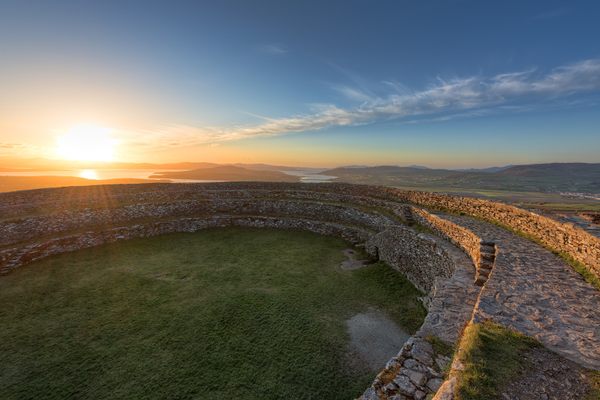
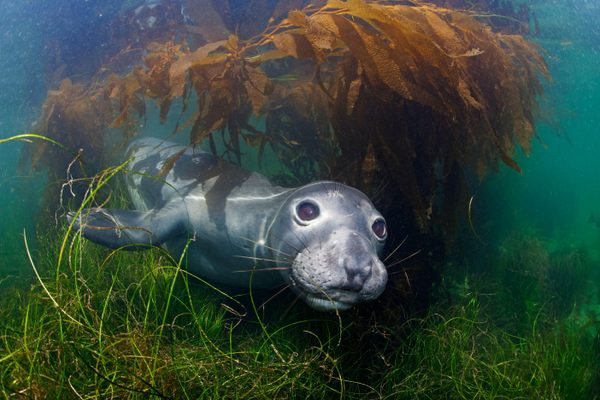
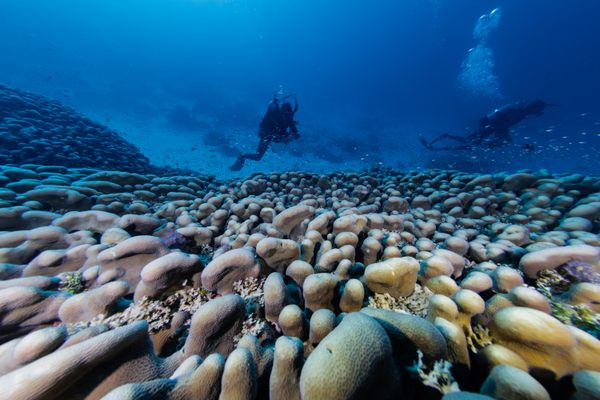
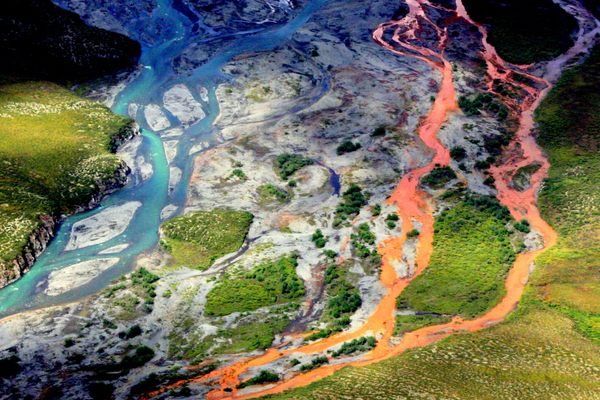





















Follow us on Twitter to get the latest on the world's hidden wonders.
Like us on Facebook to get the latest on the world's hidden wonders.
Follow us on Twitter Like us on Facebook